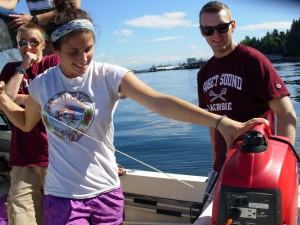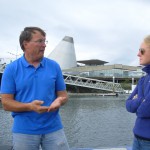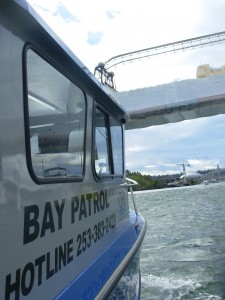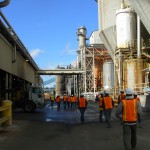It’s been the semester of field trips. I’ve been the majority of weekends this semester to explore really exciting places in around Tacoma.
In my Marine Biology class we got to spend one of the last sunny days on the boat surveying the rocky subtidal with a remotely operated underwater vehicle (ROV). It was like playing a video game, watching what happened underwater. The ROV can pick up something as heavy as a human body (yikes!!), but we just used it to pick up a Pycnopodia helianthoides, or sunflower star.
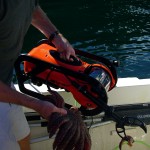
Pycnopodia and ROV.
This semester, I’m taking a ¼ credit class called Puget Sound Environmental Issues. We’re learning about the Puyallup watershed, via many different disciplines. The class is also open to members of the local community, which I felt was really beneficial to get perspective from someone who wasn’t a professor or student. The class consists of an intensive weekend of fieldtrips featuring local leaders whose occupations allow them close interaction with the watershed.
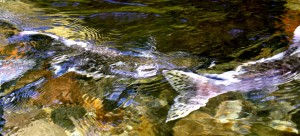
Salmon spawning along the Greenwater River. Photo credit: Rachel Ivancie
Our first speaker was Jeffrey Thomas, the Director of Timber Fish and Wildlife for the Puyallup tribe. He introduced the history of the Puget Sound region and especially focused on interactions with the Native Americans who lived in these areas before contact with explorers and settlers. I was surprised at how many of the historical buildings and streets I recognized from historic pictures of Tacoma.
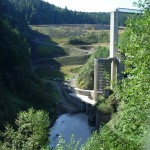
Mud Mountain Dam
On our first field day we drove from school up to Sunrise and made our way back stopping to visit areas with differing use along the way. Our first stop was in the middle of lands owned Hancock Forest Management. Hancock is a trust of private investors that own lands and harvest the timber. Doug McClelland, from the Department of Natural Resources spoke about policies and laws that govern logging practices on state and private lands. We learned that the stocks invested in Hancock lands are maturing, and it may be possible that the lands may be going up for sale soon. These lands are private,and it is possible a change in ownership could cause future development.
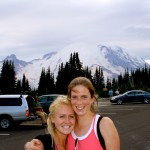
At Sunrise, Mt. Rainier. Photo credit: Rachel Ivancie
Our next stop on our way up the mountain was the Mud Mountain Dam. Our Professor, Dan Sherman,spoke to us about the history of flood control in the Puyallup watershed and how this caused big dams to be built. We stopped along the Greenwater River to see pink salmon spawning, which may have been one of the highlights of the trip. We made it up to Sunrise and hiked for a little bit before jumping back into the vans to head home. We stopped at “Sky Island” to observe the successional development in the lower parts of the watershed, where farms are giving way to housing developments. We drove back through the maze of farms, developments, industry, and patches of Muckleshoot and Puyallup reservation to get back to school.
Day two was focused on the development of Commencement Bay. We visited the FossDevelopment Authority and learned about the clean-up process that occurred. The City of Tacoma bought land on the west side of the Foss Waterway and assumed responsibility for cleaning up the contaminants there. We were able to speak to Leslie Rose, from Citizens for a Healthy Bay (CHB). CHB is a non-profit organization working with citizens to prevent water pollution and promote sustainability. She spoke about the history of the Foss clean up, which I thought was remarkable to see her perspective on the magnitude of change over the years, and still be advocating for increased change. We also got to talk to Rick Fuller, who works for the City of Tacoma about his job enforcing the contamination levels of runoff entering the Puget Sound. As we were on our tour, we witnessed the plastic covering of the 11th st. bridge rip in the wind, and sand start blowing out with the wind. The plastic was used to contain sand from blasting off lead paint, and Rick had to call in the contaminants, both sand and plastic, that were flying into the Foss Waterway. We definitely got the full experience!
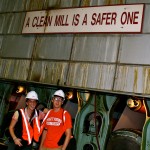
Photo credit: Rachel Ivancie
Our last stop of the day was at the Simpson-Tacoma Kraft paper mill. We visited the source of the infamous Tacoma Aroma! We learned that the smell has been drastically over the years, as they switched from new product (trees) to using more reused (recycled cardboard). We got a tour of the factory and heard about all of the environmentally based decisions the company has made over the last twenty years.
I know I keep on bragging about all of these awesome field trips I’m going on, but don’t be misled into thinking I don’t have homework. It’s midterm week already, and I have no idea where the first half of this semester went. We now have to compile everything we learned from this one weekend into a 10-page paper. Yikes! Expressing my ideas on paper is not my strong point, which may be why I’m a Biology major…
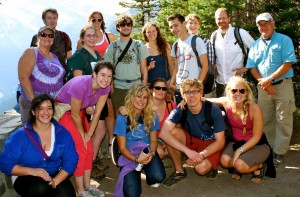
Photo credit: Rachel Ivancie
These past few weeks have allowed me to get to know the place I’ve been living in so much more detail than I have in the past four years. I was impressed to see how much this community cares about what is going on in the local landscape, and what they have done to improve it. It’s going to be hard to leave a place now that I know so much about it.

